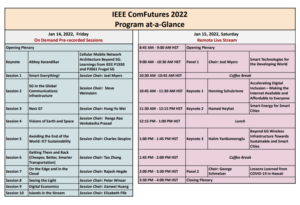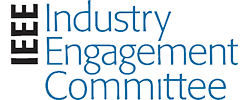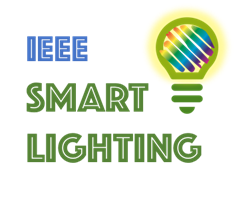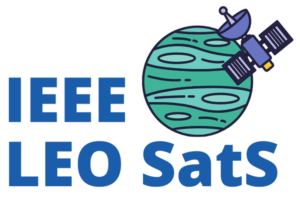Content Request and Summit Alert Sign-up

Download the Program-at-a-Glance
Explore More About Our Program and The Expert Speakers
Day 1 – January 14, 2022 (On Demand Pre-Recorded Sessions)
| Welcome Remarks – Robert S. Fish
Robert S. Fish is Chair of the IEEE Industry Engagement Committee, Past-President of the IEEE Standards Association, and Faculty Member, Department of Computer Science, at Princeton University. |
|
| Abhay Karandikar, Director, Indian Institute of Technology (IIT) Kanpur | Keynote: Cellular Mobile Network Architecture Beyond 5G: Learnings from IEEE P1930 and P2061 Frugal 5G
In this talk, we review the challenges in connecting the unconnected and argue on rethinking the requirements of 5G and beyond systems. We propose an architecture called “Frugal 5G” for affordable broadband access and IEEE P2061. We discuss the architectural elements of Frugal 5G and its implementation within 3GPP 5G framework. Specifically, we present an OpenFlow based RAN architecture which enables unified access control at the edge. Finally, we show how by using Software Defined Networking and Network function virtualization, we can realize the architecture for providing affordable connectivity. |
| Session 1 : Smart Everything!
People, places, and things are said to be getting “smart.” But what does that mean? This session will explore a range of answers to that question. Session Chair: Joel Myers, Chair of Smart Cities for the IEEE IoT Initiative, and CEO, DOMILA Ltd (Ireland) |
|
| Speaker Name | Talk Title and Link to Access |
|---|---|
| Victor Larios, Director of the Smart Cities Innovation Center, University of Guadalajara | Experiences and Lessons Learned from Guadalajara as as the Core City From the IEEE Smart Cities Community
We live a fast urbanization process where the United Nations estimates by 2050 to have 80% of the world population living in cities. In numbers, the world is moving from 35 Megacities that are cities with more than 10 million habitants to reach 100 Megacities. And even we are facing climate change with solid consequences to the environment and all living ecosystems because of fast urbanization. Hence, cities today need to commit to reducing their carbon footprint and respect their natural resources for a better quality of life. In addition, cities are moving to a digital transformation where technology enables efficiency and better decision-making based on data to manage services and infrastructures. That is the quest of the Smart Cities, where technology is only a tool that cannot succeed if there are no local innovation ecosystems enabled with continuous cooperation from government, industry, academia, and citizens. This talk focuses on lessons learned around the world and the experience in Guadalajara on its quest to become a Smart City. We introduce local innovation and city development with different technological infrastructures and applications. Finally, we in how a strategy based on incentives with a digital coin can change citizens’ behavior can help connect better the innovation ecosystem of the cities. |
| Larissa Paredes Muse, Consultant at Quanta Technology | Smart Street Lighting for a Smart Resilient Electric Grid: Leveraging Last-Mile Network Applications to Improve Power Grid Connectivity and Data-Driven Decision Making
Cities are one of the most significant sources of greenhouse gas emissions and experience the harshest consequences of grid catastrophic failures due to extreme weather events. Consequently, utilities and municipalities must respond fast to restore the grid to a minimum operational state. To better identify the conditions and the nature of the damage and, therefore, plan the infrastructure’s remediation at multiple levels, it is essential to work with reliable information. Street Lighting is part of the electric grid and is considered to be a last-mile infrastructure because it is spread throughout the city, and it is also vulnerable to the damages caused by extreme weather events. The technological advancements enable the streetlights to collect data from the physical environment and to be controlled and monitored remotely. It demands a connectivity infrastructure for data transfer, which can also be leveraged by the electric grid to improve resilience. This talk will describe how the Smart Street Lighting solutions can improve power grid connectivity and data-driven decision-making in the face of extreme weather events. |
| John Prousalidis, Associate Professor, Department of Naval Architecture and Marine Engineering, National Technical University of Athens | Smart Ports
The speech is to present a series of electrically related actions on transforming the ports into a sustainable electric energy hub extending the concept of smart grids in view of the decarbonization on both the transport and the energy sector. Within this frame, the components of a holistic approach called the “Proteus plan” elaborated by an inter-disciplinary scientific team in Greece are presented, while the case study of the port of Igoumenitsa in Greece where the “Proteus” plan implemented via the ALFION project funded by the European Commission is showcased. |
| Ask Me Anything Q/A Session: Attendees will have an opportunity to email questions for speakers, with answers returned by email. | |
| Session 2 : 5G In the Global Communications Infrastructure
The gospel of 5G has been preached for the past five years. Where are we now? Is it all that we expected? This session will encompass different viewpoints on this question. Session Chair: Stephen B. Weinstein, Independent Consultant |
|
| Tomonori Aoyama, Emeritus Professor, The University of Tokyo; President, NPO Broadband Association |
Local 5G: Japanese Approach for Private 5G
This talk introduces the R&D activities performed in Japan to establish the whole framework of the private 5G named “Local 5G.” |
| Ashutosh Dutta, Senior Scientist and 5G Chief Strategist, Johns Hopkins University Physics Laboratory (JHU/APL) | IEEE Open RAN Industry Connections Activity
Open RAN (O-RAN) technology is enabling innovation across applications, including virtualization, software-defined networking, and separation of control plane and user plane. This will enable the dis-aggregation of networks. To incubate new O-RAN standards and related products and services and complement existing industry efforts, IEEE Standards Association (IEEE SA) launched a new Industry Connections (IC) activity to develop a sustainable framework addressing the deployment, interoperability, configuration and fault management, and performance issues of the O-RAN architecture. This talk will address challenges and opportunities associated with O-RAN deployment and will discuss O-RAN related standards and research activities in various standards bodies. The talk will also illustrate some of the results from early trials and proof-of-concepts.
|
| Kevin Smith, Vice President – Technology Development and Planning, Verizon | 5G and Fiber
This talk discusses the benefits and necessity to bring both wireless & wireline technology options to the table in order to effectively close the Digital Divide. Many factors including, speed, terrain, density, supply chain, & financials all have a big impact in driving the right technology decision for the diverse geographies across the US. |
| Ask Me Anything Q/A Session: Attendees will have an opportunity to email questions for speakers, with answers returned by email. | |
| Session 3 : Next G?
Is it ever too soon to look at the future? We can’t resist! What are some of the qualities that future networks might have? Session Chair: Hung-Yu Wei, Professor, Department of Electrical Engineering, National Taiwan University |
|
| Javan Erfanian, Distinguished Member of the Technical Staff, Bell Canada | Provider Perspective
This talk will briefly outline the expected 5G path in the next several years and the journey towards beyond 5G. It will discuss the key attributes of the global initiatives for the systems of 2030 and beyond. The vision, motivation and role, and potential use cases of 6G will be highlighted, sharing insight on the context, implications and key requirements, along with research challenges and design requirements. |
| Dr. I-Kang Fu, Director, Standard Strategy, Mediatek | 6G Vision – S.O.C.: Simplexity, Optimization, Convergence
With 5G availability fast expanding worldwide and a “mid-generation” evolution cycle starting in 3GPP (Rel-18), now is the right time to lay down the foundations of the next generation towards one global 6G standard. MediaTek has played a leading role in the design & standardization of 5G and its evolution, and has led the way bringing to the market mature 5G devices that can operate in new groundbreaking 5G Systems. While current industry continues 5G technology evolution to address the aforementioned challenges, 6G technology is on the horizon to not only address these issues but also to bring fundamental transformation to mobile networks. This short presentation will provide an brief overview on MediaTek’s vision on the 6G design challenges and potential trends. |
| Dr. Xudong Wang, John Wu and Jane Sun Chair Professor, UM-SJTU Joint Institute, Shanghai Jiao Tong University | Joint Communication, Sensing, and Computing for 6G Networks
As wireless networks are evolving to 6G, communications need to be considered together with sensing. Moreover, both communications and sensing can be highly enhanced via computing and AI. Thus, joint communication, sensing, and computing has emerged as a key building block of 6G networks. This talk is focused on key research problems of joint communications, sensing, and computing for 6G networks. |
| Hung-Yu Wei, Professor, Department of Electrical Engineering, National Taiwan University | Intelligent Edge/Fog for Future 6G Networks
In 6G era, communications and computing will be closely integrated. To provide low latency services, edge/fog computing and networking technologies are needed. Management and automation for intelligent edge/fog for Next G system will be discussed. |
| Ask Me Anything Q/A Session: Attendees will have an opportunity to email questions for speakers, with answers returned by email. | |
| Session 4 : Visions of Earth and Space
From space we can see earth, and from earth, we can see space. Can this tie be exploited more deeply for communications? This session probes this question. Session Chair: Ranga Rao Venkatesha Prasad, Associate Professor, Internet of Things, Cyber Physical Systems, Delft University of Technology |
|
| Tomaso De Cola, Team Leader, German Aerospace Center (DLR) | Non-Terrestrial Networks (NTN) for 6G: Expectations and Technical Challenges
Non-Terrestrial Networks (NTN) have become an exciting technology trend since its first conception in year 2018 as part of the 5G standardisation path in 3GPP. Since then, more and more initiatives have started at world-wide level to confirm the interest and the value that such a concept can bring to future telecommunication systems, especially in all those scenarios where connectivity cannot be always guaranteed. In fact, NTN extend the traditional horizon of satellite communications in that overall airborne and spaceborne assets are envisioned in the convergence with terrestrial infrastructure, hence eventually building the vision of a real 3D network. The actual integration between terrestrial- and non-terrestrial networks, however, does not only opens up the door to new scenarios and applications for meeting societal and industry needs, but also introduces important technical challenges that have to be effectively faced towards a full system deployment, across all layers of the protocol stack. These technical implications are even more important in the case of integrated NTN-6G networks, given the uncertainty of what 6G could actually be in 10 years-time. In this light, this talk overviews the main characteristics of NTN and the envisioned scenarios benefitting from the convergence between terrestrial and non-terrestrial networks, as well as the important technical challenges to be understood and solved from the research domain in order to have an ultimate technology adoption by industry and eventually in real life. |
| William Emery, Emeritus Professor, Smead Aerospace Eng. Sci., Dept., University of Colorado, Boulder | Satellite Remote Sensing of Climate Change
While we are all experiencing events that indicate climate change the Earth orbital satellite perspective is uniquely positioned to sense the important global changes that are the larger scale evidence of climate change. Satellite remote sensing of the Earth has rapidly evolved from a global photography program to forecast the weather to a comprehensive program of Earth surface measurements that can detect and map a very wide range of important Earth surface characteristics. In addition satellites have provided a way to transfer large amounts of data from autonomous platforms measuring in situ on the Earth’s surface. We will examine some of the early indicators of global climate change such as vanishing Arctic sea ice and will discuss the implication of global sea level rise. We will examine a warming Earth and discuss the consequences for increased wildfires. Finally, we will consider the rise in atmospheric carbon dioxide as a major contributor to global climate change. |
| Witold Kinsner, Professor, Department of Electrical and Computer Engineering, University of Manitoba | LEO Satellites and Systems for Near-real Time Applications
Low-Earth-orbit (LEO) satellites and systems provide new opportunities for low-latency high-speed communications. Within the next 10 years, the number of functioning LEO satellites is expected to increase to tens of thousands. How safe and sustainable will the current LEO services be? How can we transform them to enhance various classes of communications and develop new ones? How can we use these developments to enhance experiential learning at universities, colleges vocational schools and even high-schools? |
| Ask Me Anything Q/A Session: Attendees will have an opportunity to email questions for speakers, with answers returned by email. | |
| Session 5 : Avoiding the End of the World: ICT Sustainability
We have very little choice as to whether we preserve earth as a quality environment in which humans can live. Information and Communications technology can both be an energy hog and be misused for information distribution. This session looks at how to mitigate this phenomena. Session Chair: Charles Despins, Professor, École de Technologie Supérieure |
|
| Jaafar Elmirghani, Director, Institute of Communication and Power Networks and Professor, Communication Networks and Systems, School of Electronic and Electrical Engineering, University of Leeds, UK | Sustainable Communication Networks, Cloud and Fog
Traffic continues to grow in communication networks at 30% to 40% per year thus doubling every two years and increasing by factors of 30x and 1000x in 10 and 20 years respectively. Power consumption in equipment tends to scale with data rate and thus this increased traffic can lead to power consumption levels that are not sustainable if there is no intervention. Power is consumed in communication networks and in data centres (clouds) that support the digital transformation. Edge processing (fog) can help reduce latency and reduce power consumption by bringing processing closer to end users. In this talk we will introduce a number of measures that can be taken to improve the energy efficiency of the communication networks and edge processing and outline how ICT can be used to improve sustainability in several sectors such as manufacturing and transport. |
| Saifur Rahman, Founding Director, Advanced Research Institute and Joseph R. Loring Professor of Electrical and Computer Engineering, Virginia Tech | Securing ICT for Energy Infrastructure
Today’s energy critical infrastructure is becoming highly complex; the distributed nature of this increasingly interconnected network allows for a constantly expanding cyber-attack surface. The objective of such malicious attempts on the critical infrastructure is usually aimed in the collection of information, taking control, shutting down, or even completely destroying the infrastructure at hand. This talk will focus on a multi-stage data-driven ICT framework to defend against cyber-attacks and improve the power/energy network’s security and resiliency. |
| Ramesh Ramadoss, Director, CaritaTech Inc. and Expert Panel Member, EU Blockchain Observatory and Forum | Cryptocurrency/Blockchain Evolution, Their Futures, and Related Energy Consumption Concerns
This talk will provide an overview on the evolution of cryptocurrency, blockchain and Distributed Ledger Technology (DLT). In 2009, Bitcoin was launched as a peer-to-peer electronic cash. In 2015, programmable blockchain/DLT projects such as Ethereum, Hyperledger Fabric, and R3 Corda were launched. Over the last decade, cryptocurrency/blockchain/DLT have evolved to encompass a collection of distributed computer network architectures implementing various decentralized consensus protocols and data structures. In this rapidly emerging field, some remarkable innovations, experimentation, and developments have been carried out by startups, enterprises, and governments. This talk will highlight various current and future applications of this technology. High (electrical) energy consumption by certain blockchains (e.g., Bitcoin) has raised serious environmental concerns. This talk will highlight several recent efforts to develop energy efficient blockchain architectures and solutions. |
| Ask Me Anything Q/A Session: Attendees will have an opportunity to email questions for speakers, with answers returned by email. | |
| Session 6 : Getting There and Back (Cheaper, Better, Smarter Transportation)
In a modern economy the mobility of people and things is crucial. However, it seems that we are relying on smart networks to sustain this mobility. This session looks at examples of such networks and explores what it takes to build them. Session Chair: Tao Zhang, Manager, Emerging Network Technologies, National Institute of Standards and Technology (NIST) |
|
| Bo Ai, Professor and Ph.D. Supervisor, Beijing Jiaotong University | 5G Key Technologies for Intelligent High-Speed Railways
The 5th generation mobile communication technology (5G) is a hotspot of research and attention in the international academia and industry. Multi-scene, multi-target and multi-technology integration are the important characteristics of 5G, which are different from other generations of mobile communication systems. The international telecommunication union (ITU), the world wireless research forum (WWRF), China 5G Standard Promotion Group (IMT-2020), the European Union 5G Research Organization (NGMN) and METIS all regard high-speed railway or high-speed mobility as an important scenario of 5G. High-speed railway is one of the typical vertical application industries of 5G. This report aims at the business and application requirements of future high-speed railway development, points out the necessity and scientific significance of applying 5G technology to the intelligent high-speed railway system, and the application of 5G technology in the future high-speed railway communication systems are discussed from the aspects of high-speed railway service model, network architecture, millimeter-wave communication, large-scale antenna array, beam management, ultra-reliable low time delay, mobile edge calculation, network slicing, etc. |
| Mohammed Atiquzzaman, Edith Kinney Gaylord Presidential Professor, School of Computer Science, University of Oklahoma | V2x Communication
Modern vehicles are equipped with lots of sensors for measurement of vehicle operating conditions and the surrounding, including weather conditions, and can be a viewed as a web of sensors on wheels. They can sense a range of information about the vehicle, such as location, speed, braking intensity, road traction, etc., some of which can represent road weather conditions. The talk will discuss ways to increase the safety of drivers and thus reduce crashes resulting from adverse road weather conditions. |
| Tao Zhang, Manager, Emerging Network Technologies, National Institute of Standards and Technology (NIST) | From Self Driving to Automated Mobility
In this talk, I will discuss the needs, challenges, and opportunities as we move from self-driving cars to automated mobility systems and services. |
| Ask Me Anything Q/A Session: Attendees will have an opportunity to email questions for speakers, with answers returned by email. | |
| Session 7 : On the Edge and in the Cloud
Is cloud computing obscuring our view of the network? Other architectures may lead to a clearer distribution of responsibility with other parts of the network. This session shares some ideas along these lines. Session Chair: Rajesh Hegde, Professor and Head of the Department of Electrical Engineering, Indian Institute of Technology, Kanpur |
|
| Chris Brinton, Assistant Professor, Elmore Family School of Electrical and Computer Engineering, Purdue University | Intelligence Optimization over Fog Networks
Fog networking aims to orchestrate computing tasks across the continuum of network elements from edge/IoT devices to cloud datacenters. The growth in data-intensive, latency-sensitive applications for user and network intelligence calls for careful consideration of how these tasks will be managed throughout fog networks at scale. This talk will overview the technical challenges and opportunities for fog learning, and how the topology, heterogeneity, and proximity properties of contemporary network deployments can be leveraged to elevate the fundamental tradeoff between intelligence quality and resource efficiency. |
| Mazin Yousif, Chief Technologist, Gainwell Technologies | Dispersed Computing
This talk will look at history, how complexity is trending with examples, how DARPA defines it and what are its research challenges. |
| Junshan Zhang, Professor, Electrical and Computer Engineering Department, University of California Davis | Sensors and Edge Intelligence
The very notion of the “car” is being revolutionized. Connected and Automated Vehicles (CAVs) are those with Internet access and with a variety of sensors, which enable the vehicles to sense the proximal physical environment, send and receive signals, and interact with other vehicles or entities. While the sensory data available provides tremendous opportunities for CAVs, a grand challenge is that driving decisions must take place right here right now in the vehicle, in order to meet the requirements for safety, accuracy, and latency. In this talk, I will talk about challenges and opportunities in establishing the convergence of sensing, communication, control and computing towards building the brain of CAVs; and present our studies in theory, algorithm design and testbed in this exciting area. |
| Ask Me Anything Q/A Session: Attendees will have an opportunity to email questions for speakers, with answers returned by email. | |
| Session 8 : Seeing the Light
Nanometer wavelength carriers, otherwise known as light, gives us the bandwidth to connect the world. Glass, plastic, and air are all possible media. This session will discuss some recent developments. Session Chair: Peter Winzer, CEO and Founder, Nubis Communications |
|
| Ernesto Ciaramella, Full Professor of Telecommunications, Scuola Superiore Sant’Anna | Free Space Optical (FSO) for Space Communications
The space internet is moving from a pure concept to a true network. The ever-growing need for capacity drives satellite communications to adopt Free Space Optic (FSO) systems, as they provide higher bandwidth and can take advantage of existing COTS solutions for fiber networks. FSO systems are now proposed for inter-satellite links and feeder links. Similar solutions, based on simpler subsystems, are also considered for short-range applications in intra-spacecaft communications. We will provide an introduction to the technology and review the key features of the communication systems, as well as the potential applications. |
| Loukas Paraschis, IEEE Communications Society | DCI Optical Innovations in the Evolution of Cloud Transport
This presentation reviews the DCI optical innovations in the global cloud infrastructure [1, 2] which has arguably been the most significant evolution in wireline transport networks the last 20 years. It will particularly focus on the emerging innovations in high-speed DCI beyond 400GE and transport analytics, which will be enabling further scale of cloud transport over the next 3-5 years [3-5]. |
| Muhammad Zeeshan Shakir, Reader (Associate Professor), Computer Networks, University of the West of Scotland, UK | Optical Xhaul Network for Ultra-Dense Small Cells
Driven by an emerging use of flying platforms such as unmanned aerial vehicles (UAVs) in future cellular networks and the challenges that the 6G networks exhibit, the focus of this talk is to demonstrate the evolution of the flying platforms as a novel architectural enabler for terrestrial radio access networks, e.g., small cells. These flying platforms can use Free Space Optical (FSO) communication to offer high data rate, highly reliable, and resilient fronthaul and backhaul networks. Such vertical optical networks support the ultra-dense deployment of small cells and solving the global connectivity problems in many challenging environments, e.g., backhaul/fronthaul coverage or capacity enhancements for remote areas, social gathering, and disaster affected scenarios, etc. |
| Oleg Sinkin, Distinguished Member of Technical Staff, SubCom | Submarine Cable Communications: New Trends
In 25 years of advancement, undersea transmission systems capacity increased 5 orders of magnitude. We have reached a point where transmission technology is mature and fiber capacity has approached fundamental limits. As capacity demand keeps growing exponentially, undersea systems face new challenges of scaling cable capacity, power efficiency and the increasing pressure of cost per bit reduction. We will discuss technologies and trends leading to the future. |
| Ask Me Anything Q/A Session: Attendees will have an opportunity to email questions for speakers, with answers returned by email. | |
| Session 9 : Digital Economics
Everything has a cost, especially new networks. Every network also has some benefits. How do we calculate the economic benefits of new network technologies and architectures so that we can determine whether the benefits outweigh the costs? Session Chair: Jianwei Huang, Presidential Chair Professor and Associate Dean, School of Science and Engineering, the Chinese University of Hong Kong, Shenzhen |
|
| Lin Gao, Associate Professor, School of Electronics and Information Engineering, Harbin Institute of Technology | A Socially-Optimal Mechanism for Incentivized Online Learning Framework
Multi-arm bandit (MAB) is a classic online learning framework that studies the sequential decision-making in an uncertain environment, but often overlooks the scenario where the decision-maker cannot take actions (e.g., pulling arms) directly. In this talk, we will present an incentivized online learning (IOL) framework for this scenario. To address the challenges of tight coupling of the unknown environment learning and asymmetric information revelation, we propose a socially-optimal mechanism for the IOL framework based on a specifically designed Lagrangian function. The proposed mechanism satisfies various desirable properties such as agent fairness, incentive compatibility, and voluntary participation, and meanwhile achieves the same asymptotic performance as the state-of-art benchmark that requires extra information. |
| Jianwei Huang, Presidential Chair Professor and Associate Dean, School of Science and Engineering, The Chinese University of Hong Kong, Shenzhen | Optimization and Incentive Mechanism Design for Federated Learning
As an emerging machine learning paradigm in edge computing, federated learning has received significant attention recently due to its promising performance in mitigating privacy risks and costs. In this talk, we will present an analytical study on the optimal incentive mechanism design for federated learning, in the presence of strategic edge devices’ multi-dimensional private information. |
| Joe Weinman, XFORMA LLC | Exploring the Economics of the Emerging Edge
Many simply characterize the benefits of the edge as reduced latency enabled by endpoint proximity, but the reality is that there are numerous other benefits to edge processing, storage, and networking. However, there are also a number of trade-offs between centralization and dispersion that can be modeled and analyzed to determine where to optimally deploy resources. |
| Ask Me Anything Q/A Session: Attendees will have an opportunity to email questions for speakers, with answers returned by email. | |
| Session 10 : Islands in the Stream
Humans spread across the Pacific but for some reason didn’t bring fiber optics with them. Now we have to catch up. This session examines some of the particular challenges in providing communications in and among the diverse island societies of the Pacific. Session Chair: Elizabeth Fife, Associate Professor of Technical Communication Practice, Viterbi School of Engineering and the Marshall School of Business, University of Southern California |
|
| Jeewika Ranaweera, Principal Hardware Engineer, Oracle | “Equity and Inclusion” to Bring a Digital Revolution for ALL
According to the United Nations, our world is home to more than 1.1 billion girls under age 18, who are poised to become the largest generation of female leaders, entrepreneurs, and change-makers the world has ever seen! However, there’s a significant knowledge gap on the digital realities for this generation of girls replicating the gender inequality in the current physical world. This talk will address the inequity and exclusion that takes place and actions needed to bring a gender-balanced digital revolution for all. |
| Heikki Almay, Karugrid Co-Founder | Connecting Islands by Do-It-Yourself
The presentation will first show what can be done by a mobile operator that really wants to connect an archipelago. It then discusses why you should not hold your breath while waiting for such a telco to appear to your island. Instead it proposes do-it-yourself. The second part of the presentation is about what to build. Spoiler: it is private LTE. |
| Sibesh Bhattacharya, Principal Infrastructure Specialist (ICT), Pacific Department, ADB | Improving Connectivity for the Post COVID-19 Economy
The presentation brings out the challenges in digital connectivity and the constraints, particularly Pacific small island countries facing in making internet better and affordable. It also discusses the role a development partner like ADB can play in overcoming some of these challenges. Finally, the speaker will provide the list of ADB funded cable infrastructure projects in the Pacific and highlight the future focus areas in the space. |
| Laura Hosman, Associate Professor, Arizona State University | Innovating to Build Inclusive and Empowering Internet-Ready Skills Across the Pacific
Even though connectivity is truly a challenge around the world, and nearly half the global population has yet to connect to the internet, access remains less than half the battle! Wherever access to information is a challenge, the skills associated with information literacy must be built, for people to be able to make empowering use of the internet once it does |
| Ask Me Anything Q/A Session: Attendees will have an opportunity to email questions for speakers, with answers returned by email. | |
Day 2 – January 15, 2022 (Remote Live Stream)
| 8:45 AM HST | Opening Plenary – George Schmelzer, IEEE Life Senior Member | |
|---|---|---|
| 9:00 AM HST | Joel Myers, Moderator
Toby Cumberbatch, Professor of Electrical Engineering, The Cooper Union Mohamed Essaaidi, Professor, ENSIAS, Mohammed V University Vincent Kaabunga, Director, Smart Metrics Inc. Victor Larios, Director of the Smart Cities Innovation Center, University of Guadalajara Narendra Mangra, Principal, GlobeNet LLC Georges Zissis, Professor, The University of Toulouse |
Live Virtual Panel Session: Smart Technologies for the Developing World
Traditionally affluent regions of the world have made most progress towards deploying smart cities enabling technologies. However, developing regions of the world may not have the resources to match the progress. They need to be cognizant of infrastructure, economic and policy constraints. This necessitates a different approach to realizing smart cities. This panel will discuss the challenges and approaches for addressing these significant issues. |
| Coffee Break – 10:30 AM HST |
||
| 10:45 AM HST | Henning Schulzrinne, Professor, Department of Computer Science and Department of Electrical Engineering, Columbia University | Live Virtual Keynote: Accelerating Digital Inclusion – Making the Internet Available and Affordable to Everyone
The beginnings of the internet now date back more than 50 years ago, yet about half of the world’s population is still not online. In the United States, roughly 20% of adults do not have home broadband, with significant disparities by age, race, rural vs. urban, education and income characteristics. As many core functions of society, from education to health and jobs, depend on having high-quality internet access, we need to both understand and reduce the lack of availability and meaningful adoption. This goal is now known as “digital inclusion.” Indeed, many of the 17 UN sustainable development goals likely depend on digital inclusion. I will summarize what we now know about digital inclusion and what policy and technology steps are being taken or have been tried. I will highlight the efforts in the recent US 2021 Infrastructure Investment and Jobs Act, as it is probably the largest such attempt and includes efforts far beyond the typical rural deployment strategies. These new initiatives can also benefit from new technology, standards and practices, beyond the usual development of better hardware and new protocols.
|
| 11:30 AM HST | Hamed Heyhat, Vice President & General Manager, North America | Smart Energy, Honeywell | Live Virtual Keynote: Smart Energy for Smart Cities |
| Lunch – 12:15 PM HST |
||
| 1:00 PM HST | Halim Yanikomeroglu, Professor, Department of Systems and Computer Engineering, Carleton University, Canada | Live Virtual Keynote: Beyond 6G Wireless Infrastructure Towards Sustainable and Smart Cities
In this keynote, a novel wireless infrastructure will be presented which includes a new aerial access layer composed of HAPS (high altitude platform station) constellations positioned in stratosphere, 20 km above the ground. With its bird’s-eye and almost-line-of-sight view of an entire metropolitan area, a HAPS is more than a base station in the air; it is a new architecture paradigm with access, transport, and core network functionalities for integrated connectivity, computing, sensing, positioning, navigation, and surveillance towards enabling a variety of use- |
| Coffee Break – 1:45 PM HST |
||
| 2:00 PM HST | George Schmelzer, Moderator
Francis Alueta, Director, Network Reliability, Hawaiian Telcom Dr. Song Choi, Assistant Dean, College of Engineering, University of Hawai’i at Manoa Eric Daley, Director of Information Technology, HEMIC Jim Laclair, Chief Information Officer, Punahou School, Honolulu Burt Lum, Broadband Strategy Officer, Hawai’i Broadband & Digital Equity Office Shige Minami, Director of Technology and Infrastructure, Punahou School, Honolulu Corey Shaffer, Senior Manager, Network Assurance, Verizon Wireless Jordan Silva, Senior Manager, Service Delivery | CBTS, Hawaiian Telcom |
Live Virtual Panel Session: Lessons Learned from COVID-19 in Hawai’i
The COVID-19 pandemic, which started 19 months ago, impacted society in Hawaii like nothing before. Many businesses and government organizations could not operate because of restrictions to prevent COVID-19 infections and those who did operate had to use remote work arrangements to ensure a safe work environment. Communications technology played an important role in mitigating the impact. However, there were limitations to what communications technology could accomplish. Not everyone had access to broadband services or the services that were available were not adequate. This interactive panel of professionals from various segments of Hawaii (healthcare, state government, University of Hawaii, Punahou school, and broadband providers: Hawaiian Telcom and Verizon Wireless will discuss the limitations and lessons learned in responding to the COVID-19 crisis. |
| 3:30 PM HST | Closing Plenary – George Schmelzer and Robert S. Fish
George Schmelzer is an IEEE Life Senior Member. Robert S. Fish is Chair of the IEEE Industry Engagement Committee, Past-President of the IEEE Standards Association, and Faculty Member, Department of Computer Science, at Princeton University. |
|













